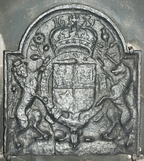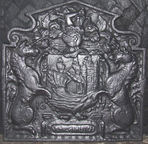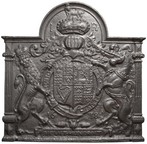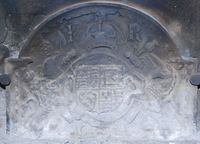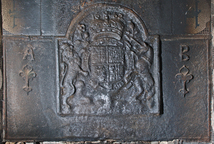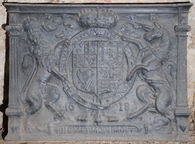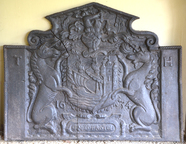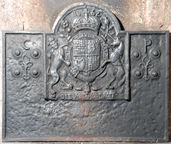-
1075
Description: Arched rectangular shape; cavetto-moulded edging (top and sides); English Stuart Royal arms, garter, supporters, crown and motto; altered date above crown.
Notes: This design, which probably dates from 1619, has been used to cast composite firebacks with a variety of altered dates ranging from 1629 to 1662.
Copies of this fireback are known.
Inscription: 1639 [illegible Garter and royal mottoes]
Arms: English Stuart royal
- Decoration tags:
- arched rectangular (shape)
- cavetto (edging)
- whole carved pattern
- individual numbers
- heraldic
- armorial
- text
Manufactured: in 1639 in the Forest of Dean area of England.
Current location: Black and White House Museum, The Old House, High Town, Hereford, Herefordshire, England.
-
355
Description: Rectangular joined to pediment by symmetrical scrolls; fillet edging with embattling inside; shield, helm, crest, supporters and mantling of the city of Bristol; date split by bottom of shield; inscription in an oval cartouche below shield.
Notes: Both '3's in the date are a substitution, with another casting suggesting an original date of 1614 or 1624. The pattern-maker was also responsible for carving royal coats of arms in three West Country churches and a small number of series of firebacks in the first quarter of the 17th century.
Copies of this fireback are known.
Inscription: 16 33 / [ARMES] BRISTOLL
Arms: City of Bristol
- Decoration tags:
- rectangular with detached pediment (shape)
- fillet (edging)
- whole carved pattern
- individual numbers
- armorial
- text
Manufactured: in 1633 possibly in the Forest of Dean area of England.
Current location: Kenilworth Castle, Kenilworth, Warwickshire, England.
Museum number: 88278827 (part of the English Heritage museum group)
- Attached to series:
- Civic firebacks
- Bristol armorial series
-
277
Description: Arched rectangular with cavetto-moulding along top, supported by Ionic pilasters; English Stuart royal shield, garter, helm, crown, motto and supporters; date below and either side of garter.
Notes: One of several firebacks, all of the same date, but varying in size, framing style and moulding; all have stylistic features in common and will have been the work of the same pattern maker, who was also responsible for carving royal coats of arms in three West Country churches.
Copies of this fireback are known.
Inscription: I R [Jacobus Rex] / HONI SOIT QVI MAL Y PENSE / 16 18 / DIEV ET MON DROIT
Arms: English Stuart royal (James I)
- Decoration tags:
- arched rectangular (shape)
- complex individual (edging)
- whole carved pattern
- architectural
- armorial
- royal
- text
Manufactured: in 1618 possibly in the Forest of Dean area of England.
Current location: Museum of London, 150 London Wall, London, England.
Museum number: 80.271/92 (part of the Museum of London museum group)
-
502
Description: Arched rectangular shape; embattled cavetto-moulded edging; shield, garter, supporters and crown of James I of England; a branch sprouting a rose and leaf to the left of the crown, a branch sprouting a thistle and leaf to the right; initials at top, split by crown; date below shield.
Notes: Similar in style to the 1619 series, this plate has larger rose and thistle plant stamps and was probably designed by the same pattern-maker
Copies of this fireback are known.
Inscription: I R / 16 21
Arms: English Stuart royal - James I
- Decoration tags:
- arched rectangular (shape)
- embattled cavetto (edging)
- whole carved pattern
- armorial
- royal
Manufactured: in 1621 in England.
Current location: Newick Park Hotel, Newick, East Sussex, England.
-
1144
Description: Composite; arched rectangular shaped, armorial fireback, cavetto edging, with Stuart Royal arms, garter, supporters, crown and motto, and 1662 date above crown; this overlies a rectangular plate with fillet edging; top centre in the space each side of the central shield, an initial letter - A to left, B to right - each above a fleur-de-lys, its stem terminating in a small buckle.
Notes: Several firebacks have incorporated the same Stuart royal shield, which probably originally dated to 1619, but with the date altered. A similar fireback, but without the initials and fleurs-de-lys, dated 1661, and reputed to have come from the Totsey, the old guildhall at the market cross in Gloucester, is illustrated in Ames, 1980, 23; possibly the same fireback was reported by the late David Bick to be at The Grange, Minsterworth, Gloucestershire (demolished in the late 1960s).
Inscription: 16 62 / [Garter motto (illeg.)] / A B
Arms: English Stuart royal
- Decoration tags:
- arched rectangular (shape)
- fillet (edging)
- carved stamps
- carved pattern panels
- composite
- individual letters
- heraldic
- armorial
- royal
- text
Manufactured: in 1662 possibly in the Forest of Dean area of England.
Current location: in private hands, Norton, Wiltshire, England.
Citation: Ames, A., 1980, Collecting Cast Iron (Ashbourne, Moorland Publishing).
Citation: Badeni, J., 22 Sep 1983, 'Whose Fireback?' [letter], Country Life, 174, 4492, p. 772.
-
519
Description: Rectangular; Ionic pilasters at sides, architrave on top; English Stuart royal shield, garter, crown, motto and supporters; date below and either side of garter.
Notes: One of several firebacks, all of the same date, but varying in size, framing style and moulding; all have stylistic features in common and will have been the work of the same pattern maker, who was also responsible for carving royal coats of arms in three West Country churches. A plaster cast of a fireback of this design is displayed as the royal arms in St George's church, near Abergele in north Wales.
Copies of this fireback are known.
Inscription: HONI SOIT QVI MAL Y PENSE / 16 18 / DIEV ET MON DROIT
Arms: English Stuart royal (James I)
- Decoration tags:
- quasi-rectangular (shape)
- complex individual (edging)
- whole carved pattern
- armorial
- royal
- text
Manufactured: in 1618 possibly in the Forest of Dean area of England.
Current location: Penshurst Place, Penshurst, Kent, England.
-
952
Description: Rectangular joined to pediment by symmetrical scrolls; fillet edging with embattling inside; shield, helm, crest, supporters and mantling of the city of Bristol; date split by bottom of shield; inscription in an oval cartouche below shield; rectangular side extensions with twisted rope edging; initial on each extension.
Notes: The mismatched ‘3’ in the date is likely to have replaced a ‘1’ or ‘2’. The pattern-maker was also responsible for carving royal coats of arms in three West Country churches and a small number of series of firebacks in the first quarter of the 17th century.
Inscription: T H / 16 34 / ARMES BRISTOLL
Arms: City of Bristol
- Decoration tags:
- rectangular with detached pediment (shape)
- fillet and rope (edging)
- whole carved pattern
- individual letters
- individual numbers
- planklines
- extension panels
- armorial
- text
Manufactured: in 1634 possibly in the Forest of Dean area of England.
Current location:, not known.
- Attached to series:
- Civic firebacks
- Bristol armorial series
-
348
Description: Composite; Arched rectangular shaped, armorial fireback, cavetto edging, with Stuart Royal arms, garter, supporters, crown and motto, and 1662 date above crown; this overlies a rectangular plate, with rope-effect, fillet edging; a pattern of four rosettes surrounding a fleur-de-lys, its stem terminating in a small buckle, is repeated on each side of the central armorial fireback, with the initials above; each rosette is stamped separately.
Notes: A variant, bearing the same date, but the initials, A B, and without the rosettes, is at Norton Manor, Malmesbury, Wiltshire.
Copies of this fireback are known.
Inscription: 16 62 / C P / HONI SOIT QVI MAL Y PENSE / DIEV·ET·MON DROIT
Arms: English Stuart royal
- Decoration tags:
- arched rectangular (shape)
- fillet (edging)
- carved stamps
- whole carved pattern
- composite
- individual letters
- armorial
- royal
- text
Manufactured: in 1662 possibly in the Forest of Dean area of England.
Current location: Tiverton Castle, Tiverton, Devon, England.
(part of the Colchester & Ipswich Museums Service museum group)
-
254
Description: Curved ogee-arched rectangular with egg and dart moulding along top, supported by Ionic pilasters; English Stuart royal shield, garter, helm, crown, motto and supporters; date below and either side of garter.
Notes: One of several firebacks, all of the same date, but varying in size, framing style and moulding; all have stylistic features in common and will have been the work of the same pattern maker, who was also responsible for carving royal coats of arms in three West Country churches.
Copies of this fireback are known.
Inscription: HONI + SOIT + QVI + MAL + Y + PENSE / 16 18
Arms: English Stuart royal (James I)
- Decoration tags:
- quasi-arched rectangular (shape)
- complex individual (edging)
- whole carved pattern
- planklines
- armorial
- royal
- text
Manufactured: in 1618 possibly in the Forest of Dean area of England.
Current location:, not known.
